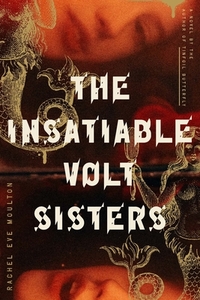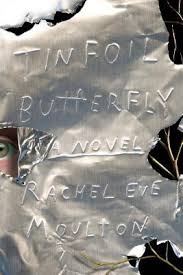The Insatiable Volt Sisters by Rachel Eve Moulton
 Wednesday, April 5, 2023 at 7:34AM
Wednesday, April 5, 2023 at 7:34AM 
Published by MCD x FSG Originals on April 4, 2023
The Insatiable Volt Sisters is a literary horror story. Unless the author is Mary Shelley, I’m not sure that “literary” and “horror” belong in the same sentence. Stephen King (to whom Rachel Eve Moulton seems to pay homage by naming a character Carrie) once argued that writers either create genre fiction or literature but not both. In later years, after sharpening his writing talent, King backed away from that position, but there is some truth to the suggestion that plot-focused genre fiction isn’t easily blended with literary fiction’s focus on character and setting and deep themes. Some writers perform that trick, but Moulton sacrifices the storytelling that horror fiction demands by focusing on her literary aspirations. In the end, Moulton uses the trappings of horror fiction to dress up a domestic drama that explores feminist themes. She never manages to create the buildup of dread that is essential to a good horror story.
The plot cycles between 2000 and 1989, although the reader learns much (maybe too much) about the early history of Fowler Island in Lake Erie. We are told at least twice that Eileen and Elizabeth Fowler, sisters who developed the power to communicate with each other without speaking, built the island’s downtown and roads, as well as the Island Museum. Elizabeth married Seth Volt, who dug a quarry and built a Victorian house that islanders call Quarry Hollow. Legend has it that Seth imprisoned Elizabeth in the house, separating her from her sister. They learned to communicate by telepathy to overcome their separation.
The half-sisters Henrietta (Henri) and Beatrice (B.B.) are descendants of Seth Volt. They were born two years apart to different mothers but were often mistaken for twins, perhaps because their mothers looked so much alike. Their father James, a reclusive poet who somehow made a living, apparently had a type. After Olivia Rose vanished, James knocked up Carrie and brought her to the island as his new wife. The sisters grew up in Quarry Hollow and know it to be haunted, perhaps by Oliva Rose, but not by her alone.
Fowler Island is where depressed women go to die. “The island feasts on female sadness. It licks it up like ice cream.” Women visit the island and disappear, perhaps by jumping (voluntarily or otherwise) into the quarry, which is now filled with water. The quarry is known to the Volt sisters as the Killing Pond. Nobody seems to care about the missing women. Their bodies are never recovered so they are quickly forgotten. Moulton seems to be making a heavy-handed argument that society in general doesn’t care about women, although in most places, when someone comes across a female foot that has been detached from its body, the police at least investigate. Not on Fowler Island.
The island devil, a “great big and dripping thing with leathery fins,” lives in the Killing Pond. Perhaps bodies never surface because they are consumed by the monster, apart from the stray foot. When, on occasion, “the essential part” of the monster walks on land, it can change its shape to suit its whims. The monster’s true identity is a barely concealed secret until Moulton decides to state the obvious.
The other key character is Sonia, the curator of the island museum who helps mop up the blood and feet when women disappear. Sonia helped James raise B.B. after Olivia Rose disappeared.
For reasons that are revealed near the novel’s end, Carrie separated from James without warning, leaving the girls to fear that she had disappeared like Olivia Rose. After she returned, the girls sensed that Carrie would leave James and made drama because they feared she would only take her biological daughter with her. Their scheme to remain inseparable ends with a transformative experience for Henri. The island is indifferent to the scheme because it has plans for the Volt sisters.
Early in the novel, in a chapter that takes place in 2000, B.B. finds her father’s body, minus a part he seems to have shed. B.B. calls Henri to deliver the news. When Henri tells her mother that she will return for the funeral because B.B. needs her, Carrie reminds Henri that the island is “a magnet for trouble” and a “lighthouse for disaster.” Carrie eventually agrees to join Henri although she vows not to enter Quarry Hollow. Really, she should have known better. In any event, the Volt sisters are together once more.
The plot is all over the place. It combines a haunted house story with one of demonic possession while exploring sisterly relationships under extreme circumstances, failed marriages under extreme circumstances, and the disappearances of women who fled extreme circumstances. Themes of female despair and empowerment drive the novel. I don’t think it’s a spoiler to note that the ghosts who haunt the house are the residue of the women who died on the island. In death as in life, they are enslaved by toxic masculinity. Exactly why that is true is never addressed. It seems to be assumed that male demons feed on women because that's what men do.
The eventual show of strength displayed by the Volt sisters is a stretch, if only because their acquisition of girl power is unconvincing, even in a horror novel that demands suspension of disbelief. A late scene in which Carrie and Sonia overcome adversity by battling a devil while they’re underwater is just silly. So is the thought that ghosts of dead women urge a living woman who allies with them to “be strong” and “not to quit” until they transform the woman into “a lightning bolt of a girl.” You go, sisters! This is the kind of plot I might expect from a comic book. I just couldn’t take it seriously.
Because the novel is literary, Moulton devotes great attention to character development. Carrie and Sonia are collateral characters but they relate their thoughts in detail — Carrie’s thoughts of how it feels to be a disappearing mother, her changing feelings about James and the plan she made to escape from the island, her fear of the house and of James’ potential responsibility for the vanishing women; Sonia’s thoughts of being a maternal stand-in and the custodian of island lore. The detail slows the pace, inhibiting the fear that the novel never conjures.
Descriptions of the island monster crawling out of the goop are a bit chilling, until we realize that it’s a standard lizard monster with changeling powers. Moulton’s failure to enliven a horror story with original ideas leaves a shell that she fills with striking sentences and an ode to sisterhood that, while well-intentioned, falls short of being compelling.
RECOMMENDED WITH RESERVATIONS
